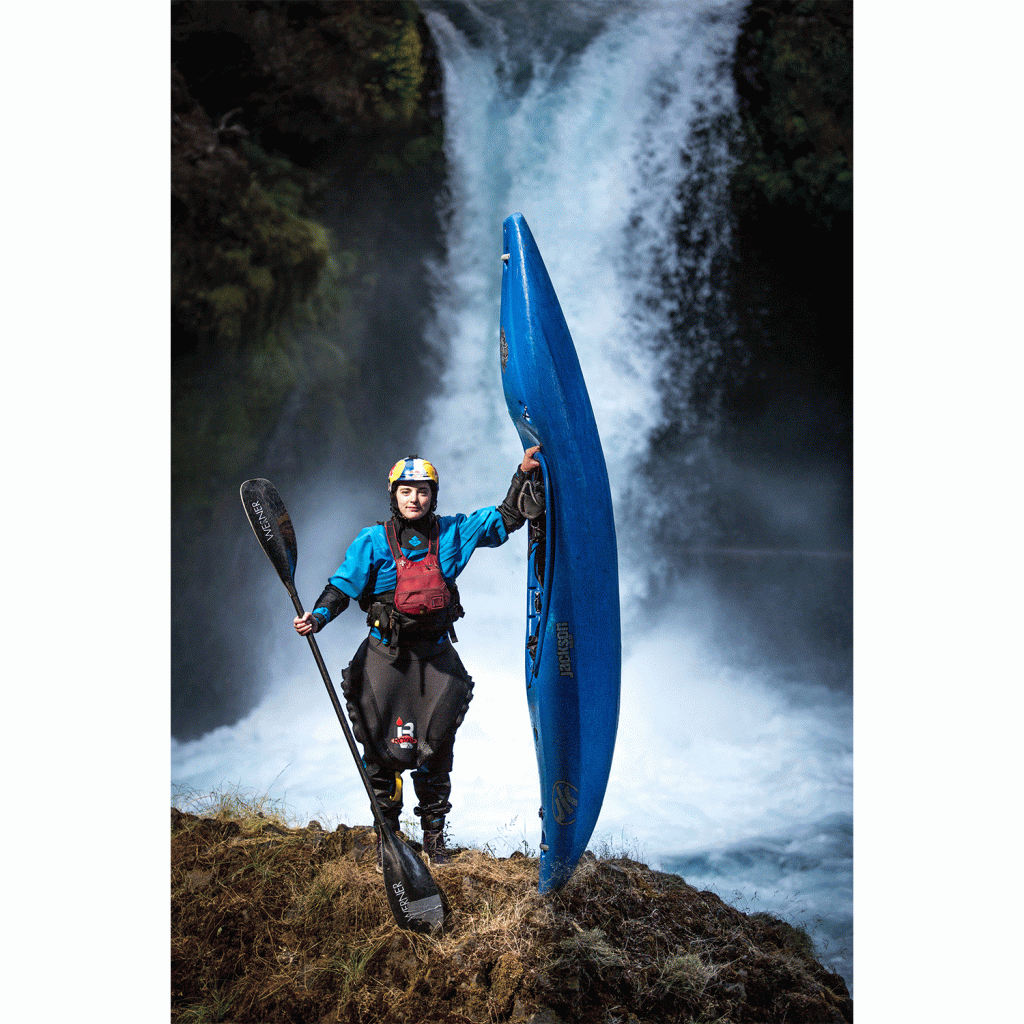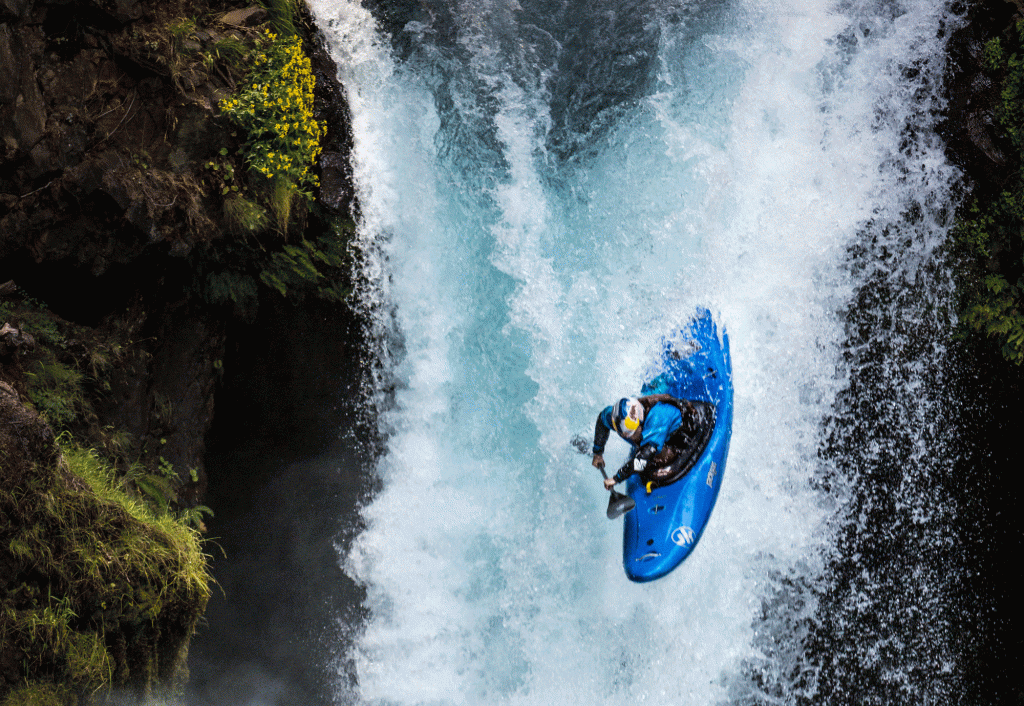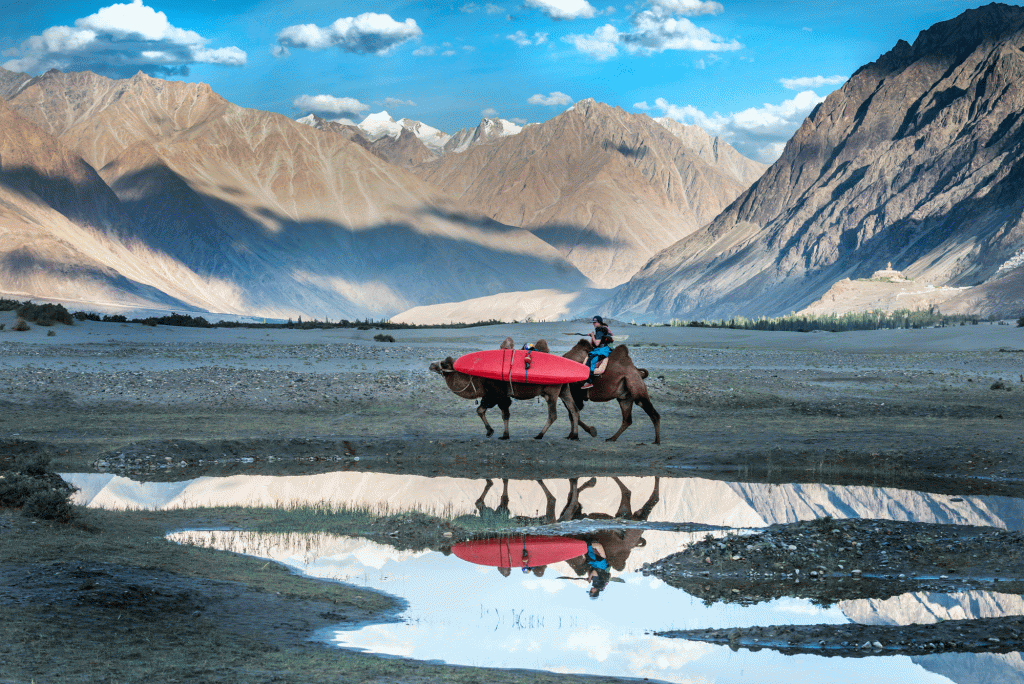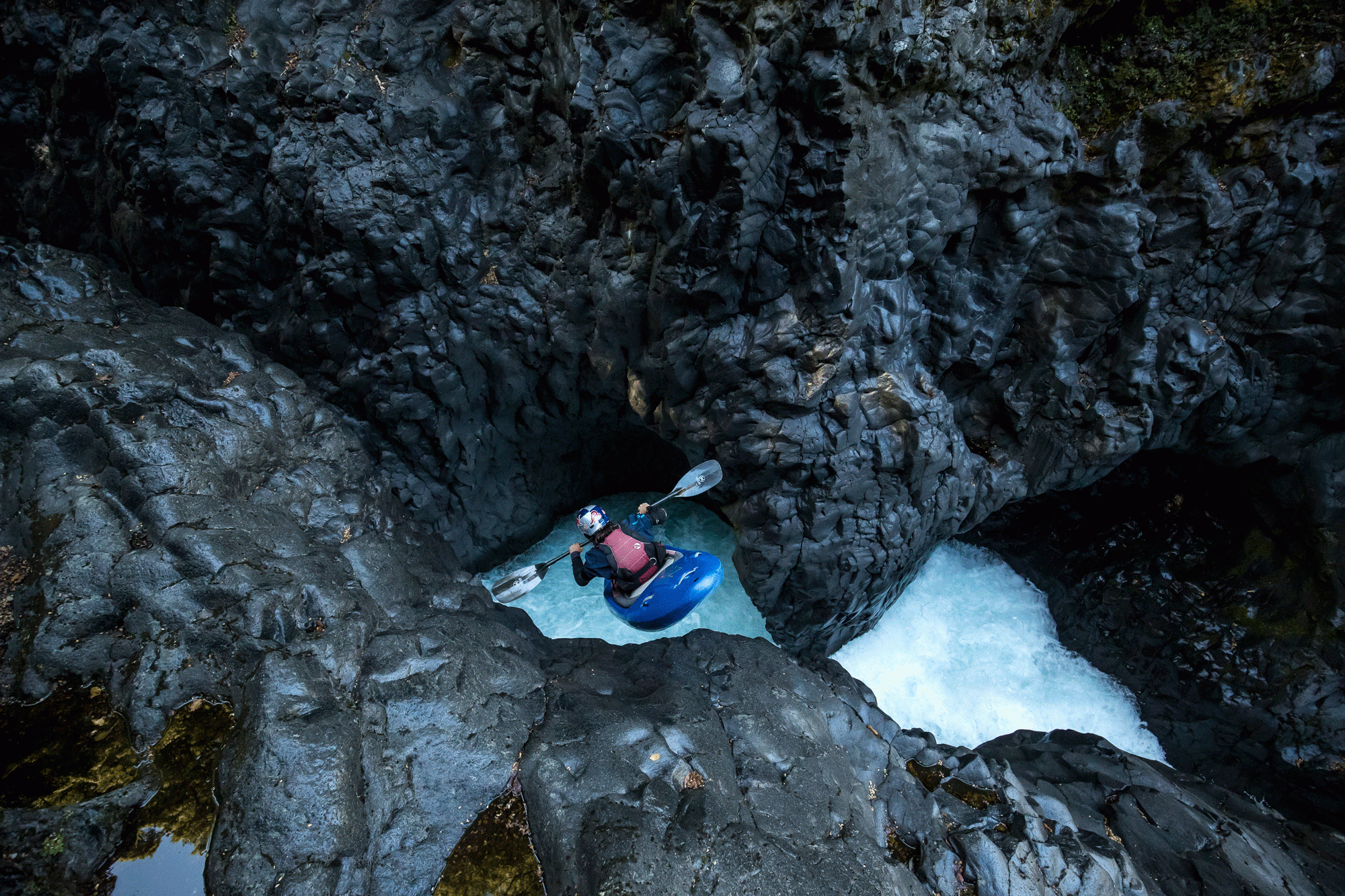Nouria Newman is a student of fear.
The 27-year-old Frenchwoman is widely viewed as one of the best kayakers on the planet. She’s paddled some of the world’s most vicious rapids and waterfalls, won whitewater and slalom championships, and explored first descents on remote rivers. She completed her master’s thesis on how fear is socially constructed, and in a sport dominated by men, she’s broken down barriers for women in competitions and by advocating for equality. She’s most at peace in Class V whitewater.
It’s real life she finds terrifying.
Last spring, the North Fork Championship (NFC), known as the most extreme kayak competition in the world, announced its first-ever women’s division, thanks in large part to Newman’s advocacy. But in June, the famed paddler was forced to skip the historic event in Crouch, Idaho. After submitting to an in-depth visa application process, Newman was denied a visa by the U.S. Embassy in Paris, with officials stating she lacked a legitimate profession or apparent stability in France. It threw her entire world into chaos, not only leaving the respected athlete in danger of losing sponsorships and income from U.S. prize money, but also delegitimizing her entire way of life, in spite of her massive contributions to the sport.
Newman started paddling because her parents forbade it. When she was five years old in Tignes, France, she laid eyes on a kayak for the first time and announced that she would learn to use it. “They told me no, because I didn’t know how to swim,” she recalled. “So I asked them to take me to swimming lessons and they forgot about my request until I came back with a swimming degree. Then they had to take me to the kayak club.”
She didn’t start out as fearless. She wasn’t immediately taught the roll that lets paddlers recover from a flip. Without a roll, when a paddler flips upside down, they have to pull the spray skirt, exit the kayak, and swim to safety. The swim through rapids can be terrifying, from strong currents, standing waves and recirculating holes that hold onto human bodies, to hazards like boulders and logjams.

Newman poses after paddling Washington state’s Little White Salmon River on July 8, 2018. (Photo Credit: Erik Boomer)
It left Newman afraid of whitewater—but as one of the few girls in her kayak club, she said, she wasn’t expected to push through fear to try things. That doesn’t mean she got off easier, though. “Sometimes I was so scared I would pee in my boat. I had a terrible coach and he would say it out loud in front of everyone, publicly shaming me: ‘You peed in your kayak.’”
When she was eight years old, a family friend taught her how to roll on a vacation in Costa Rica. No longer scared to flip in whitewater because she could right herself, she started surpassing the other kids in the club, even the coach. “I went from being the scared little girl to being less scared than the boys,” she said. “But it had nothing to do with gender. It was confidence.”
Newman started young on the slalom race circuit, quickly making a name for herself paddling around the world. That’s where she met Canadian paddler Katrina Van Wijk. “I distinctly remember that she always came at it with a kind of confidence I wasn’t used to in other female paddlers,” Van Wijk said. Van Wijk would go on to make history in 2014 as the first woman to race in the finals of the NFC on the Class V+ Jacob’s Ladder rapid; Newman followed in 2015 as the only woman in a field of 19 men.
As Newman began paddling more technical water, she found herself fielding the same sentiment over and over: How amazing that you’re a girl and you’re not afraid. She began thinking that perhaps this concept that women are more fearful than men was a social construct that was reinforced beginning at a young age. The idea intrigued her so much that she completed her master’s thesis in sociology on the subject at university in Toulouse in 2018.
Newman conducted research on the White Salmon River in Washington state, carrying a recorder as she paddled and paused to ask every female kayaker she encountered for an interview. She paired their responses with research from the same Tignes kayak club she’d attended, now comprised of a new generation of kids and a different coach than the one she’d had in her early days.
“Usually, when coaching a group of small boys and girls, if girls are hesitant, they’re not pushed the same way boys are,” she says, speaking from a combination of her own experience and findings from her research. “But that slalom coach treated boys and girls the same way, and the girls seemed just fearless,” she said. “It wasn’t that they weren’t scared; they just weren’t conditioned to be scared and back down.”

Nouria Newman paddles off Spirit Falls on Washington States Little White Salmon River on July 8, 2018. (Photo Credit: Erik Boomer)
While Newman’s slalom racing career took off during her teens and early twenties, she also exploded onto the whitewater scene, demonstrating a breadth of skills that many paddlers lack. In 2016, she got the call from Adidas Sickline Extreme Kayak World Championship, an invitation-only race held on the Wellerbrücke rapid in the Austrian mountain town of Oetz. Newman refused on the grounds that the famous race didn’t have a category for women. The organizers claimed that there weren’t enough women to paddle it.
“Open a women’s category and there will be,” Newman replied.
The following year, Adidas Sickline opened its first female division. After more prodding from Newman, who observed that the paddlers who were men received prize money while the women didn’t, and that the women weren’t guaranteed to race the same finals course as the men, Sickline committed: In 2017, the women’s division received equal pay, equal media broadcasting, and the same race course. Newman won the women’s world championship, and her run stacked up more views than the run by the winning man.
Her Sickline win wasn’t just historic; it was validating. Kayaking is mainly a U.S. sport dominated by men; as a French woman, Newman had fought her whole kayaking career to prove herself. After Sickline, that sentiment of Wow, you’re a female kayaker and you’re not afraid, morphed into You’ve got balls. For Newman, this wasn’t exactly a compliment; it illustrated the limbo so many athletes who are women find themselves in. “It’s hard for women in outdoor sports to find their place,” she said. “You’re either not capable, or if you are capable, you’re associated with masculinity, even if it’s not direct.”
In 2018, Adidas pulled its sponsorship and Sickline fell by the wayside, leaving a void in the extreme whitewater scene. That same year, Newman’s slalom times began to fall, due in part to injuries from repeated shoulder dislocations and a full surgery. Eventually, the French Canoe Kayak Federation pulled their financial support of her racing. “To basically hear, ‘We’re kicking you out because you’re slow and old’—that was hard,” she said. “One day you wake up in the morning and know you’re going to train two to three times per day to compete. The next day you don’t know what to do. I’d just finished my studies, I’d lost my part-time job, and I’d been kicked out of the training center, so I lost access to the gym, the physio, my coach, my training group.” Most athletes hope to end their racing careers on a high, perhaps with a medal. But Newman was forced to end her slalom racing career on her worst season yet.

Newman performs in the lower Indus river in the Himalayas, India on August 19, 2018. Editor’s Note: This image was not taken on Nouria Newman’s solo trip itself; but was re-created in the same region in the following days. (Photo Credit: Ali Bhamal)
Shortly after, in August 2018, she flew to India to compete in the whitewater Malabar River Fest, and opted to stay a bit longer to go north and solo kayak the famously beautiful Zanskar as it flows into the great Indus. She needed the solitude, and she wanted to think.
Expedition kayaking, usually comprised of a multiday trip, often on remote rivers and sometimes involving first descents, is a different beast than the well-catalogued whitewater that most paddlers make the rounds on, explains pro kayaker Ben Stookesberry, who’s paddled with Newman on numerous first descents in South America. “There’s this big beautiful blank slate where you can write your own story without skipping the details, and that fits Nouria—her style of paddling is about seeing the river for itself.”
As for Newman’s approach to fear, Stookeberry sums it up like this: He watched her rappel down from a cliff into the base of the falls of the Salto Engano, a first descent in Argentina that he, Newman and Erik Boomer were considering. She stuck her head directly into the thunderous plunge, wanting to immerse herself in the worst, most violent part of the waterfall to see if it was something she wanted to attempt. “Then she was the first one of us to run it. She can stay with some of those dangers and use that as a motivation to paddle toward the light.”
Due to widespread flooding, the rivers in India were enormous. On day two of paddling alone, coming up fast on a big whitewater section, Newman missed a move and got pinned on top of a siphon, a deadly river feature where water flows beneath boulders, potentially jamming other objects that try to pass through. Stabilizing herself and staying calm as the water roared around her, she began to pull her safety gear from her PFD in hopes of levering herself out of her boat and onto the rock. But she tipped, and was sucked out of her boat straight into the siphon and under a rock. “I thought, This is it. At this point I wasn’t scared. I was really calm. I just thought, You’re such [an] idiot if you die like this.”
The hydraulics, her own efforts, and no small amount of luck finally shot her back to the surface. She swam through the rapid to chase down her kayak—she would have been stranded without it in the high-walled remote canyon. She made it to a small beach, towing her heavy, water-laden kayak before the next set of rapids, cold and exhausted. Ribs bruised, scared and demoralized, she faced several more days of paddling alone.
“At least on the rapids you can’t think. But on all the flatwater, everything just comes out. The hardest of all was to be with the real source of my own fear on the rest of that river and realize … what if I’m just going away on trips to escape, because I can’t face that I’m a failure?”

Nouria Newman seen at the Nubra Valley in the Himalayas, India on August 20, 2018. (Photo Credit: Ali Bhamal)
Just months after Newman safely made it home to France, in January, the NFC announced it was stepping into the void left by Sickline to become the world’s extreme whitewater championship. And they announced their first-ever women’s division, with equal pay for winners. The paddling community predicted Newman would dominate.
But less than a month before NFC, she was denied her visa. She saw her kayaking career flash before her eyes. The biggest races are held in the States, and those races represent prize money (a primary source of income for Newman) and a chance to deliver on sponsor expectations like paddling the NFC’s inaugural women’s category. But the deeper cut was personal: In her visa interview, the immigration officer told her to come back when she had a “proper job” and could demonstrate more stability.
She wanted to scream at him. She’d fought her whole life to legitimize professional whitewater kayaking. And now she was told it “didn’t fit the boxes.” “What scares me is that I have to conform to social pressure: get a proper job, buy a house and a car, get married, not live with my mom at 27 years old,” she said. “But I’m terrified to get involved in a relationship, to think about settling down. I’m not good at ‘proper life.’ Kayaking has always been a way to escape from this.”
In June, 18 women made history paddling the NFC’s first women’s division, and Norwegian Marriann Saether took first. There’s no way to know how Newman would have placed, but that doesn’t stop some of the long-time paddlers from speculating. “I do think that Nouria would have destroyed that category, and she would have been able to compete with the men,” said Stookesberry. But the opportunity to prove it has passed.
Newman isn’t sure what’s next. She knows that kayaking is the thing that makes her happiest, and that at its heart, it’s about so much more than escaping the fear of “real” life. It’s about the feel of being on the river and moving through beautiful places. It’s about the people she paddles with. It’s about exploring what’s around the next corner, that glorious unknown where she can make her own decisions on a stretch of water.
No matter what the future holds, her impact as a professional kayaker is already undeniable. “As a woman, as a person, it doesn’t even matter the gender, she’s pushing the limits of kayaking, and it has this crazy trickle effect,” said Van Wijk. “She’s inspired so many new kayakers. Even if she’s not the reason they kayak, she might be the reason they look at things a little differently, or have the ability to dream bigger. She’s allowed little girls to have that dream of being on the leading edge of the sport one day.”
